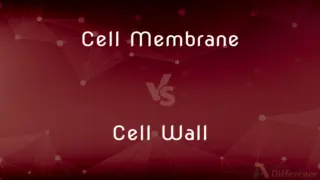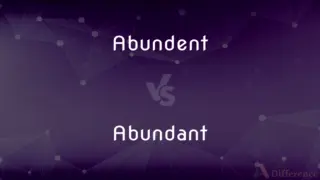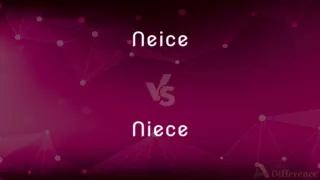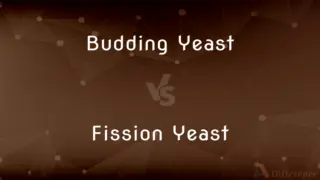Covalent Bonds vs. Ionic Bonds — What's the Difference?
By Tayyaba Rehman — Published on October 22, 2023
Covalent Bonds involve sharing of electrons between atoms, while Ionic Bonds result from the transfer of electrons from one atom to another.

Difference Between Covalent Bonds and Ionic Bonds
Table of Contents
ADVERTISEMENT
Key Differences
One unique feature of Covalent Bonds is that they can be either polar or non-polar, based on the electronegativity differences between bonded atoms. Ionic Bonds, due to their nature, always result in charged ions with distinct positive and negative charges.
Tayyaba Rehman
Oct 22, 2023
Molecules with Covalent Bonds can exist as solids, liquids, or gases at room temperature. These compounds tend to have low boiling and melting points. However, compounds with Ionic Bonds are often solid at room temperature, exhibiting high boiling and melting points.
Tayyaba Rehman
Oct 22, 2023
Atoms joined by Covalent Bonds have similar or close electronegativity values. This ensures even sharing of electrons. In contrast, atoms with Ionic Bonds have a large difference in their electronegativity values, leading to electron transfer and ion formation.
Tayyaba Rehman
Oct 22, 2023
In Covalent Bonds, electrons are shared between two non-metal atoms, which creates a strong bond due to shared electron pairs. Conversely, Ionic Bonds form when an atom donates an electron to another atom, typically between a metal and a non-metal.
Tayyaba Rehman
Oct 22, 2023
Covalent Bonds create molecular compounds where atoms remain distinct entities. On the other hand, Ionic Bonds result in the formation of lattice structures with repeating patterns of positive and negative ions.
Tayyaba Rehman
Oct 22, 2023
ADVERTISEMENT
Comparison Chart
Types of Atoms Involved
Typically between non-metals
Typically between a metal and a non-metal
Tayyaba Rehman
Oct 22, 2023
Structural Result
Molecular compounds with distinct atoms
Lattice structures with repeating ion patterns
Tayyaba Rehman
Oct 22, 2023
ADVERTISEMENT
Definitions
Covalent Bonds
Attractive forces resulting from shared electron pairs.
Methane (CH4) has Covalent Bonds among its carbon and hydrogen atoms.
Tayyaba Rehman
Oct 02, 2023
Ionic Bonds
Bonds stemming from electron transfers leading to charged entities.
Ionic Bonds give aluminum chloride (AlCl3) its crystalline structure.
Tayyaba Rehman
Oct 02, 2023
Covalent Bonds
Non-metal to non-metal atomic connections based on electron sharing.
Water (H2O) contains Covalent Bonds between hydrogen and oxygen atoms.
Tayyaba Rehman
Oct 02, 2023
Ionic Bonds
Electrostatic forces of attraction between cations and anions.
Potassium bromide (KBr) consists of Ionic Bonds.
Tayyaba Rehman
Oct 02, 2023
Covalent Bonds
Chemical links characterized by evenly distributed electron pairs.
Covalent Bonds give stability to the nitrogen molecule (N2).
Tayyaba Rehman
Oct 02, 2023
Ionic Bonds
Chemical links resulting from the attraction between oppositely charged ions.
The bond in calcium fluoride (CaF2) is an example of Ionic Bonds.
Tayyaba Rehman
Oct 02, 2023
Covalent Bonds
Bonds in which atoms achieve stability by sharing electrons.
The bond in a hydrogen molecule (H2) is an example of Covalent Bonds.
Tayyaba Rehman
Oct 02, 2023
Ionic Bonds
Bonds formed when atoms transfer electrons, producing ions.
Sodium chloride (NaCl) forms due to Ionic Bonds between sodium and chlorine.
Tayyaba Rehman
Oct 02, 2023
Covalent Bonds
Chemical bonds formed by the sharing of electron pairs.
The oxygen molecule (O2) is held together by Covalent Bonds.
Tayyaba Rehman
Oct 02, 2023
Ionic Bonds
Connections established when one atom donates and another accepts electrons.
In magnesium oxide (MgO), Ionic Bonds hold the compound together.
Tayyaba Rehman
Oct 02, 2023
FAQs
What causes the formation of Ionic Bonds?
Ionic Bonds form due to the transfer of electrons, creating oppositely charged ions.
Tayyaba Rehman
Oct 22, 2023
Can Covalent Bonds be found in metals?
Typically, no. Covalent Bonds are primarily between non-metal atoms.
Tayyaba Rehman
Oct 22, 2023
Which bond type results in the formation of ions?
Ionic Bonds result in the formation of positive and negative ions.
Tayyaba Rehman
Oct 22, 2023
What's an example of a compound with Covalent Bonds?
Carbon dioxide (CO2) is a compound with Covalent Bonds.
Tayyaba Rehman
Oct 22, 2023
Are Covalent Bonds stronger than Ionic Bonds?
It can vary, but generally, Covalent Bonds in molecules like diamond can be extremely strong, while some Ionic Bonds can also be very robust.
Tayyaba Rehman
Oct 22, 2023
How do electronegativity differences impact Covalent Bonds?
Differences in electronegativity can lead to polar Covalent Bonds, where electron sharing is uneven.
Tayyaba Rehman
Oct 22, 2023
How are Covalent Bonds formed?
Covalent Bonds are formed when atoms share electrons.
Tayyaba Rehman
Oct 22, 2023
Can you give an example of a compound with Ionic Bonds?
Sodium chloride (NaCl), common table salt, has Ionic Bonds.
Tayyaba Rehman
Oct 22, 2023
Are Ionic Bonds typically conductive in solid form?
No, compounds with Ionic Bonds usually conduct electricity when dissolved or molten, not in solid form.
Tayyaba Rehman
Oct 22, 2023
Can compounds with Covalent Bonds conduct electricity?
Typically, compounds with Covalent Bonds are non-conductive, though there are exceptions like graphite.
Tayyaba Rehman
Oct 22, 2023
Author Spotlight

Written by
Tayyaba RehmanTayyaba Rehman is a distinguished writer, currently serving as a primary contributor to askdifference.com. As a researcher in semantics and etymology, Tayyaba's passion for the complexity of languages and their distinctions has found a perfect home on the platform. Tayyaba delves into the intricacies of language, distinguishing between commonly confused words and phrases, thereby providing clarity for readers worldwide.

















































